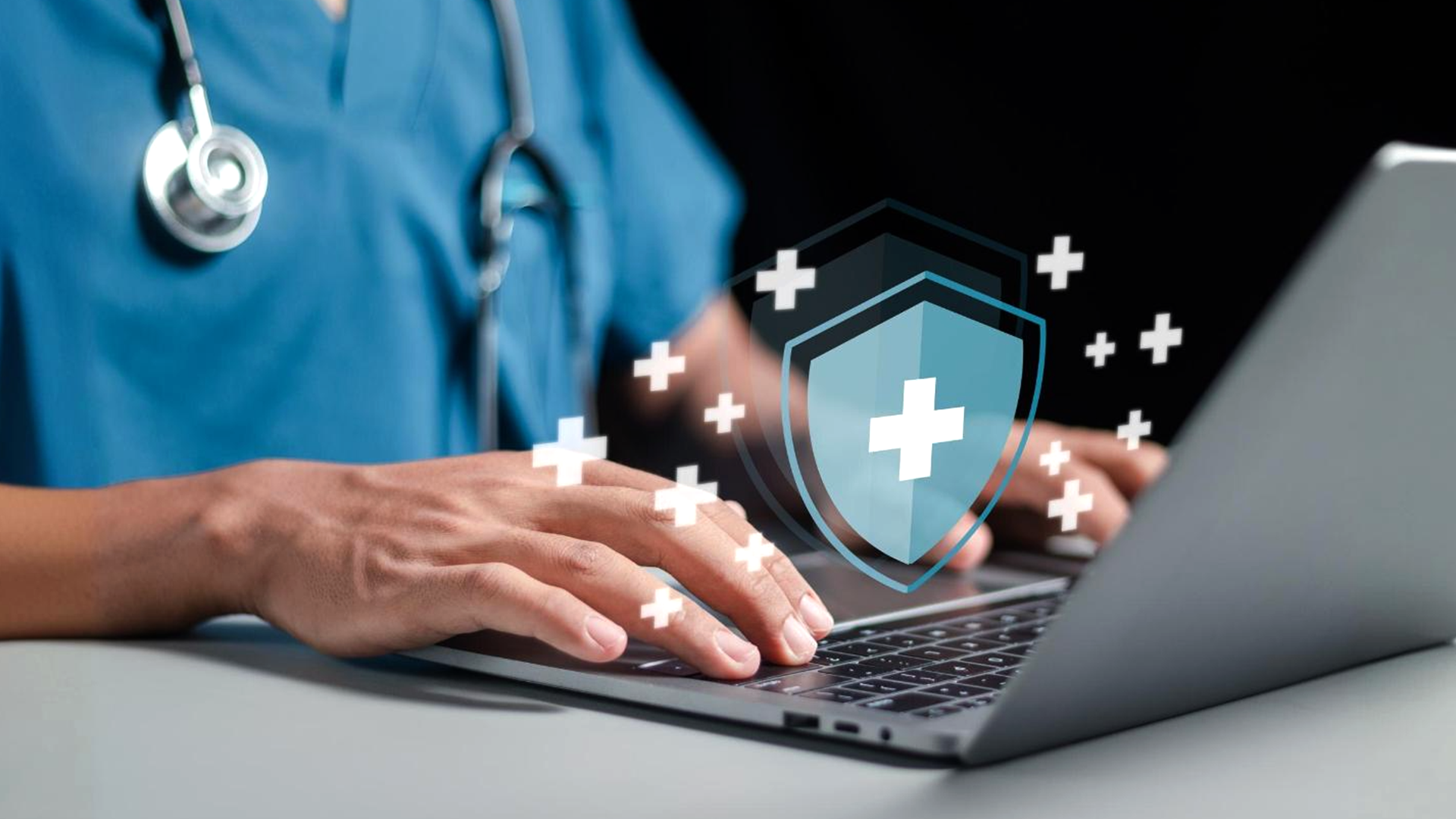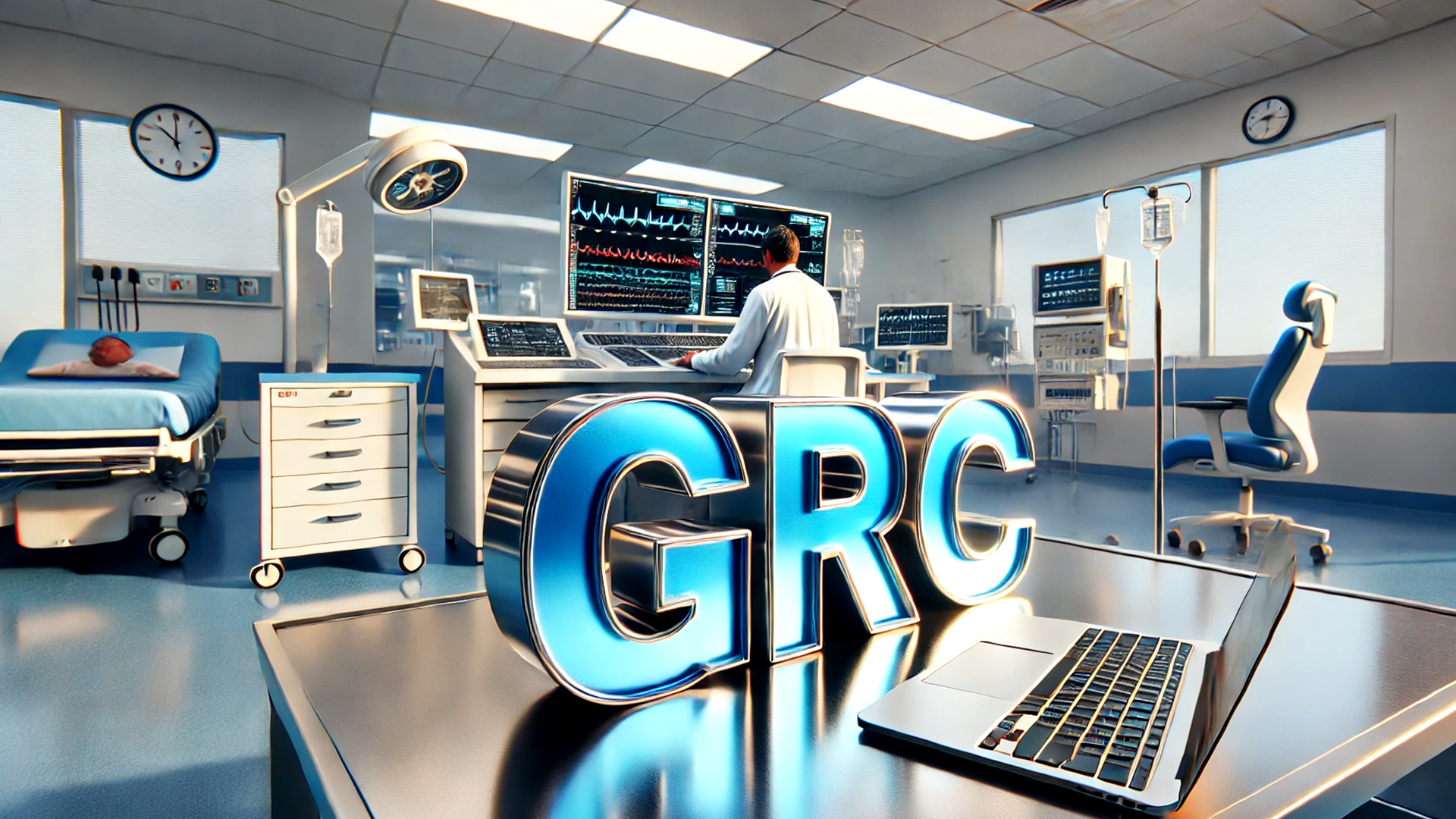
Thank you
Our team of industry domain experts combined with our guaranteed SLAs, our world class technology .


Get Immediate Help
Governance, risk, and compliance (GRC) helps healthcare organisations safeguard their systems and protected health information (PHI), manage security and compliance risks, and enforce strong corporate governance.
Using frameworks, such as GRC, is important for organisations as they continue to face risks of various types, digital, legal, financial, and reputational.
In this article, we’ll learn why you should implement GRC in your healthcare organisation.

Cyberattackers heavily target the healthcare industry. In 2023 alone, data breaches exposed over 133 million patient records. Let’s understand the reason why the healthcare industry is one of the biggest victims of cyber attacks:
Sensitive Patient Data
The healthcare industry is a goldmine for protected health information (PHI). It contains information, such as name, social security numbers, health records, payment card details, and more.
Cyberattacks look for such valuable data that is worth plenty of money. They can sell this data on the dark web or to competitors, or launch targeted attacks on people and steal money. Failing to protect patient data privacy puts the healthcare organisation under legal scrutiny and heavy fines.
Critical Systems
Healthcare organisations use different types of systems to manage records, operate equipment, and enforce treatment protocols. Systems, such as electronic health records (EHR), computers, healthcare applications, IoT devices, etc., store vital patient information. Some also provide critical patient care, such as MRI machines and ICU systems (eg, patient monitors, ventilators, ECG machines, etc.).
If you don’t secure these systems, attackers can get to sensitive patient data, take control of medical devices, and disrupt operations. They can even prevent you from providing life-saving treatments. Healthcare organisations can’t afford operational downtimes as lives are at risk, and end up paying ransom to restore operations.
Lack of Time
Healthcare professionals operate under high-pressure environments and handle patients with life-threatening health conditions. Due to lack of time, they may not be fluent in following healthcare cybersecurity best practices or prioritise patient care over security protocols.
While saving lives, complexity in using systems may introduce small system errors (e.g. leaving ports open in a hurry). This may not mean anything in medical terms, but it does for healthcare cybersecurity. If an attacker finds these errors, they could exploit the error or vulnerability to launch an attack and control systems.
Outdated Security
Despite year after year attacks in the healthcare industry, not every organisation is serious about securing its data and systems. Many of them still rely on outdated systems, services, and security protocols.
Since healthcare institutions use hundreds of devices, applications, and equipment and store plenty of data in interconnected systems, traditional security measures are not enough to protect them. A security loophole in one system can pave the way for the attacker to compromise other systems.
Regulatory Changes
Data protection laws and regulations change due to changing technologies and attackers’ evolving methods. Compliance standards, such as HIPAA, UK GDPR, NIS2, and local laws require organisations to keep up with these changing regulations and stay compliant with them.
Non-compliance can lead to hefty fines and lengthy legal proceedings. For instance, due to a data breach that exposed 78.8 million records, Anthem Inc. had to pay $16 million as a settlement for violating the HIPAA Data Security Rule.
Lack of Cybersecurity Expertise
Not every organisation has a dedicated cybersecurity team to manage incident and security posture. They may have a general IT staff who may not be specialised in healthcare cybersecurity skills.
So, if a sophisticated attack, such as APT, ransomware, etc. strikes, your IT team may not respond that well. As a result, the attacker could breach your wall and steal data.
Balancing Security and Operational Efficiency
Most organisations struggle to balance cybersecurity controls and operational efficiency. For example, accessing a sensitive system may require a user to pass multi-factor authentication (MFA). Due to multiple steps in the process, workflow could slow down. While it’s harmless in other scenarios, it could be lethal in emergency scenarios.

Healthcare organisations deal with various types of security threats aiming to compromise your systems and operations. Some of the common ones include the following:
Ransomware Attacks
In a ransomware attack, the hacker tricks a user into downloading malware into their system, which allows the hacker to access the critical system and data. They move laterally and exfiltrate data. Next, the hacker encrypts sensitive healthcare data and demands a ransom to hand over the decryption key to unlock the data. If you refuse, they can expose your data publicly or sell it to the wrong hands.
According to a report, ransomware extortions increased by 46% from Q3 2024. Since healthcare organisations provide critical medical care, system downtimes could directly affect patients.
Phishing
The next most common cyber threat for healthcare organisations is phishing attacks. In this type of attack, the attacker sends spam email to users but appears to come from a legitimate source. They trick the user into downloading the malware into their systems by instructing them to click a link or download an attachment.
Once they do, the malware gets installed and allows the attacker to access your system. This way, the attacker can misuse patient or business data to do more harm.
Data Breaches
An attack can breach your business or patient data security controls through various means – by exploiting a system vulnerability, phishing, misconfigurations, and more. Once they have access to your systems, they gain unauthorised access to EHRs, EMRs, etc.
As a result of a data breach, you lose patient trust and may face regulatory fines in the thousands or millions of dollars. According to an IBM report, the cost of a data breach in 2024 was US$4.88 million.
Insider Threats
Healthcare organisations too faced insider threats. An internal cyberthreat happens when an organisation’s employee exposes confidential data or leaves vulnerabilities, intentional or unintentional, that attackers can exploit.
If it’s unintentional, it could happen due to an accident, carelessness, or poor security hygiene. If it’s intentional, the reason could be corporate espionage, revenge, or greed.
Medical Device Vulnerabilities
Vulnerabilities in medical devices and equipment, such as imaging systems, blood pressure monitors, computers, smart wearables, etc., could trigger cyberattacks. The scary thing is, most of these systems don’t prioritise security by design and attackers find them easy to compromise and steal sensitive data.
DDoS Attacks
In a distributed denial of service (DDoS) attack on healthcare, the hacker floods a medical application or system with too many requests that it becomes unresponsive or crashes. This helps them take control of the system, manipulate data, and cause other harms. It may disrupt emergency services and delay critical patient care. As a result, organisations lose their patients' trust and may face non-compliance fines.

Governance, risk, and compliance (GRC) is a cybersecurity strategy that helps an organisation manage corporate governance policies, cybersecurity risks and threats, and healthcare compliance standards.
The Open Compliance and Ethics Group (OCEG) first suggested the name “GRC” in 2007. Implementing GRC in healthcare helps you coordinate your processes, technologies, and people. It offers two main advantages to organisations:
Apart from the above, GRC helps you cut down costs due to non-compliance and recovering from cyber attacks. It also enables you to improve your decision-making process and how well you manage security risks and meet the requirements of regulatory compliance healthcare standards.
Organisations of different types and sizes can benefit from GRC. It’s actually essential for companies operating under heavily regulated industries and following strict laws and regulations, such as healthcare, defence, finance, military, and more.
The three components of GRC - governance, risk, and compliance. Let’s understand what they truly mean:
Governance
Governance is how you as a leader handle and control your organisation to achieve your short-term and long-term business goals, while maintaining ethics and integrity. It includes certain rules, policies, strategies, and frameworks to manage:
For example, a sound corporate governance in a healthcare organisation can include a sustainable waste management policy with strategies like reduce, reuse, and recycle.
Effective governance ensures that the top-level leaders know the activities at all levels and everyone’s effort is aligned with business goals and meeting customer needs. It also helps you distribute responsibilities, rewards, and rights fairly. This type of governance creates a healthy environment for everyone in the company and balances their interests.
Risk Management
Risk management in healthcare simply means how you handle and minimise risks in your business that could disrupt your operations and cause damages. These risks are of different types - security, compliance, strategic, financial, reputational, and legal. They fall in three categories:
A healthcare organisation must create a predictive risk management plan to identify, prioritise, and mitigate risks and use data breach prevention measures to safeguard PHI.
For example, to detect security weaknesses in your systems, you can conduct a risk assessment using automated tools. Once you find the vulnerability, fix it immediately so that an attacker can’t find and exploit it to launch a bigger attack.
With an effective healthcare risk management plan, you can lower risks in your business and achieve your goals. It also helps you reduce costs, uncertainties, and improve business continuity. For this, you must continuously monitor your systems and processes for physical and digital risks and human errors. Communicate issues immediately to the security team or leaders for faster resolution.
Compliance
The third and last component in GRC, compliance, refers to meeting the requirements of applicable standards, regulatory bodies, and authorities. If you don’t comply, you could face lawsuits, fines, and penalties. Some of the standards and regulatory bodies include:
For example, if you are a UK-based healthcare services provider that operates in the US, you will need to comply with HIPAA regulations.
This is why you must create a thorough and effective compliance policy to cover all the requirements and standards you apply to. This requires you to assess your current compliance status by conducting a compliance audit and finding weak areas to improve. You must also keep on tracking the changes in these requirements and adjust your processes and train your employees accordingly.

Implementing GRC in healthcare brings plenty of benefits:
Business Efficiency
Without a proper way to manage risks, compliance, and corporate governance, you may end up wasting your time and resources. With everything all over the place, some important things may also fall through the cracks. It could result in security loopholes, non-compliance, and other business risks.
GRC in healthcare simplifies how you handle risks, compliance, and governance to ensure you don’t miss out on anything. It uses tools to monitor resources and optimises policies, and uses the data to improve your decision-making. It gives you better control over your people, process, and resources, find and mitigate risks faster, and meet compliance without errors. This way, you get closer to achieving your goals and maintain business continuity.
Manage Risks
Physical, digital, and strategic risks and human errors could expose your organisation to attacks and compromise your data and system.
GRC gives you a broader view on these risks to help you manage them and protect your organisation. For example, you can use a vulnerability scanner to find vulnerabilities in your systems and applications and remediate them immediately. This means attackers can’t find them or use them to attack your systems.
Similarly, you can review your physical security to find loopholes and correct them to keep away intruders. You can also set up strict access controls to reduce the chances of internal threats.
Creating these frameworks as a part of your GRC plan helps you reduce risks and improve your physical and digital security.
Better Compliance
Changing technologies and attackers' methods have made laws and regulations more strict. Healthcare compliance standards, such as HIPAA, require organisations operating in the US to comply with their requirements or else face heavy fines and penalties.
Compliance is one of the components of GRC. This means it helps you meet compliance requirements that apply to you and avoid costly fines. You can set procedures to track compliance requirements, make changes to improve compliance, and stay out of trouble.
Reduced Reputation and Financial Losses
Failing to secure your systems or meeting compliance requirements can bring financial and reputational losses. Weak security controls allow attackers to easily target your systems and breach them to steal data and launch bigger attacks. Once they have PHI and other sensitive information, they can sell it to the wrong hands or target your patients. As a result, your patients could stop trusting you. Meanwhile, data protection standards and authorisations increase scrutiny on you and pose heavy fines.
With GRC you have a system to manage these risks. You can secure your systems to protect yourself from security and non-compliance risks. The framework keeps you accountable and forges greater trust from partners and patients.

If you have made up your mind to enforce GRC in your organisation. Here’s our step-by-step plan that you can follow:
Create a GRC Framework
The first step is to gather a team and create a GRC framework. To do this, you will need to know what risks and business challenges you face in your healthcare organization. It could be meeting compliance, protecting critical systems, coordinating with staff, and more.
This will help define your GRC framework’s objectives. The plan should help you meet your business goals and make better decisions while maintaining high standards of security and compliance.
Evaluate Processes
Identify problems in your organisation that you are yet to address. The example of this can be third-party security risks, legacy systems, outdated policies, etc. Take time to improve your business operations using your governance, risks, and compliance framework.
Get People On-Board
You can’t expect your GRC plan to succeed if your stakeholders, such as senior leaders, mid-level and lower-level employees, and partners, are not on-board with your plan.
Start from top-level employees and explain to them the benefits of implementing GRC in your organisation. Discuss the complete plan and budget to get them to agree with you.
Next, educate the rest of the employees on GRC and how it can help them, so they don't take it lightly. Enforce GRC organisation-wide.
Set Responsibilities
Once onboard, define their roles and responsibilities. For example, senior leaders, such as CEOs, can oversee and approve the GRC framework and the chief risk officer (CRO) can supervise daily GRC activities.
Bring people from different departments, finance, legal, CIO, CTO, etc. You must also set up clear individual tasks and a reporting process to ensure everything falls in the right place.
Test GRC
Test your GRC framework periodically to ensure your policies are clear, correct, and relevant to the present environment. Adjust if something isn’t right. Reevaluate rules and responsibilities to make necessary changes.
If you operate in the healthcare industry, you need an effective way to manage risks, compliance requirements, and governance controls. Microminder’s GRC services are created to help you achieve exactly that. We use AI in healthcare cybersecurity to improve risk management and protect patient data. Here’s our capabilities for GRC in healthcare:
Strong governance: We help you monitor your resources, enforce stronger policies and controls, and enforce your decision making process with powerful data.
Risk management: Use our GRC software and services to find and mitigate business risks. We offer vulnerability scanners, penetration testing, and other tools to automate and improve healthcare risk management.
Compliance: Track and manage compliance with regular audits and adjustments to stay aligned with applicable regulations, such as HIPAA.
Book a call to explore our GRC services
Don’t Let Cyber Attacks Ruin Your Business
Call
UK: +44 (0)20 3336 7200
KSA: +966 1351 81844
UAE: +971 454 01252
Contents
To keep up with innovation in IT & OT security, subscribe to our newsletter
Recent Posts
Penetration Testing | 10/11/2025
Cloud Security | 07/11/2025
Cybersecurity | 06/11/2025
Why is information security governance important?
Strong information security governance helps you protect your sensitive data from getting into the wrong hands and prevent attacks.What is the role of the GRC team?
The GRC teams manage the GRC policies and strategies to ensure everyone follows them and they are applied in all processes.What are the 7 pillars of clinical governance?
Clinical effectiveness Staff management Risk management Clinical audit Information management Patient and public management Training and education